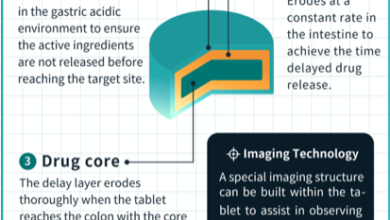
the solution to antimicrobial resistance?
[ad_1]
The discovery of penicillin in 1928 by Alexander Fleming was a watershed moment in the world of healthcare, eventually leading to the development of antibiotic drugs that allowed doctors to treat once severe and life-threatening illnesses and infections. But our reliance on antibiotics has now led to an emerging global health problem in the form of antimicrobial resistance, resulting in the need to once again find new treatments to help fight potentially lethal infections.
Antimicrobial resistance occurs when bacteria, viruses, fungi and parasites evolve over time and stop responding to the drugs normally used to treat them. As a result, infections become more difficult to treat, increasing the risk of spreading disease, severe illness, and death. Misuse and overuse of antimicrobial drugs, such as antibiotics, is another major factor in the development of drug-resistant pathogens.
The World Health Organization (WHO) lists antimicrobial resistance as one of the top 10 global public health threats facing humanity, and is expected to cause around 10 million deaths per year by 2050.
Accordingly, there has been an increased focus on the development of new antimicrobial agents, with antimicrobial peptides (AMPs) – a class of small peptides widely occurring in nature – emerging as one of the most promising solutions to potentially overcome antimicrobial resistance.
What are antimicrobial peptides and how can they be used to overcome antibiotic resistance?
Fleming didn’t just discover penicillin; he also discovered the antibacterial properties of lysozyme – the first natural antibiotic isolated from the human body – in 1922. Since then, many types of molecules exhibiting antimicrobial activity have been isolated from animals, plants, insects and bacteria. Eukaryotic AMPs, which describe antimicrobial peptides derived from organisms whose cells possess a nucleus, became a focus area of research in the mid-20th century, and there are now more than 3,000 AMPs reported in the Antimicrobial Peptide Database (APD) originating from the six kingdoms of life; animals, plants, fungi, protists, archaea, and bacteria.
But what exactly are antimicrobial peptides? Also known as host defense peptides, antimicrobial peptides are small, naturally occurring molecules that play an important role in the innate immune response of nearly all living organisms, exerting a variety of inhibitory effects against bacteria, fungi, parasites, and viruses.
The mechanism of action (MOA) of antimicrobial peptides has been studied extensively since their discovery, and their multifaceted MOAs potentially make them a promising alternative to traditional antibiotics, especially in dealing with multidrug-resistant pathogens.
“The use of AMP as an active antibacterial component is attractive because of its low potential to induce new types of resistance, which can be attributed to its multifaceted mode of action. AMP interacts with the bacterial cell wall and has broad-spectrum effects on gram-positive and gram-negative bacteria. In addition, they are effective against antibiotic-resistant bacteria, making them a valuable tool in preventing and treating infections caused by them,” explained Martin Andersson, professor in the Department of Chemistry and Chemical Engineering at Chalmers University of Technology.
Generally, antimicrobial peptides use two broad MOAs to target bacteria and kill them. In the first MOA, the antimicrobial peptides induce membrane disruption, resulting in cell lysis and death, whereas in the second MOA, the antimicrobial peptides enter cells without membrane disruption and inhibit essential intracellular functions, binding to nucleic acids or intracellular proteins.
Andersson said he believes antimicrobial peptides have the potential to become vital components in the battle against antimicrobial resistance.
“Overall, AMP has the potential to replace traditional antibiotics and treat infections that are currently untreatable. This approach is critical in combating antimicrobial resistance, which is fueled by inappropriate and overuse of antibiotics,” he commented.
In addition, studies have shown that some antimicrobial peptides and conventional antibiotics have a synergistic effect, meaning that antimicrobial peptides and antibiotics can also be used in combination to kill drug-resistant bacteria, prevent drug resistance, and ultimately enhance the therapeutic effect of antibiotics.
Progress towards creating AMP-based therapies
Despite the promising potential of antimicrobial peptides to combat antimicrobial resistance, creating a wide range of AMP-based therapies can be challenging. This is because antimicrobial peptides generally have short half-lives and break down quickly when they come into contact with body fluids, such as blood. They can also be expensive to produce.
However, efforts to create product candidates from antimicrobial peptides are expected to increase in the coming years thanks to a better understanding of antimicrobial peptide MOAs, innovative formulation strategies, and advanced chemical synthesis protocols to lower production costs.
In addition, several antimicrobial peptides are currently undergoing preclinical and clinical trials, and there have been several recent research projects that have shown particularly promising results, including the development of new antibacterial agents for use as wound sprays, and the creation of new strains. antibiotics that can be modified quickly to overcome future resistance.
The wound spray was developed by researchers at Chalmers University of Technology in Sweden. Andersson was the principal investigator for the study and said the spray was a suspension of particles in water, consisting of a hydrogel containing chemically attached antimicrobial peptides, which was an improvement over earlier wound dressing materials made in sheet form of a similar material.
“The active ingredient of the spray, the particles, can penetrate deeper into the wound bed, thus increasing the accessibility of the material to the bacteria in the wound. For the particles to be effective, they must make physical contact with the bacteria, as they act as a contact killing agent. This spray was developed in response to requests from clinicians looking for more effective wound care options,” says Andersson.
New materials developed for sprays have been shown to be effective against a wide range of bacteria, including antibiotic-resistant strains such as methicillin-resistant. Staphylococcus aureus (MRSA), and has the potential to prevent infection, thereby reducing the need for antibiotics.
“This spray has the potential to be used in any environment where bacterial growth is undesirable, especially in environments where human cells are present, because the particles are not toxic to our cells,” Andersson said.
Meanwhile, scientists at RMIT University recently created a new strain of antibiotic called priscilicidin – derived from indolicidin, a natural antibiotic found in the immune system of bovines – that has a simple design, allowing it to be produced quickly and cost-effectively in a laboratory. It can also be adapted to address different types of antimicrobial resistance.
“Priscilicidin is a very short peptide that we rationally designed from natural antimicrobial motifs and synthetic gelling motifs. Thanks to their very short molecular size, they are easy and cost-effective to manufacture. Its molecular structure can also be easily modified to overcome future resistance, optimize activity against microbial strains, and adapt viscosity to application,” explains Céline Valéry, senior lecturer in pharmaceutical sciences at RMIT University and principal supervisor of RMIT University. Study.
According to Valéry, priscilicidin has been shown to be very active against Candida strains, including resistant strains. For this reason, the research team’s initial focus was on the preclinical development of priscilicidin-based therapies against fungal infections.
Moving on from therapeutics, another promising tool in the field of antimicrobial peptide research is the AI-powered AMP prediction model developed by researchers from the Gwangju Institute of Science and Technology (GIST) in South Korea. Named AMP-BERT, this tool is a classification system that uses an AI-based bidirectional encoding representation of the transformers architecture (BERT) that enhances the current AMP classification model.
AMP-BERT is able to capture the functional and structural properties of peptides and classify them as AMP or non-AMP, enabling it to make better classifications even with external data. This enhanced classification system has the potential to aid the development and discovery of AMP-based drug candidates and therapies.
“As more AMPs are experimentally validated and new structural information is uncovered using computational methods, we will be able to make more effective antibiotic drugs and potentially stop the spread of new pandemics worldwide in the near future,” said Hojung Nam, who led the research. study together with Hansol Lee.
Research on antimicrobial peptides is constantly evolving, and with recent technological advances and enhanced understanding of antimicrobial peptide MOAs, it is likely that further progress will be made in developing more AMP candidates in the coming years, to the market for antimicrobial peptides. estimated to be worth around $539.32 million by 2027.
“While there is still much research needed to fully optimize the use of AMP as an antimicrobial agent, I think it is likely that we will see more AMP-based drugs and therapies available in the future,” said Valéry.
New technologies related to antimicrobial peptides:
[ad_2]
Source link






